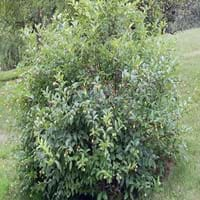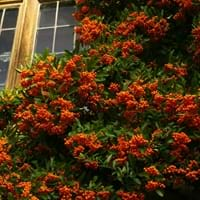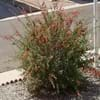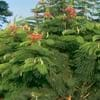Life Span
Annual and Perennial
Annual and Perennial
Type
Shrub
Broadleaf Evergreen
Origin
South Africa
Hybrid origin
Types
Not Available
Pyracantha ‘Soleil d’Or’ (Firethorn)
Pyracantha ‘Red Column’ (Firethorn)
Pyracantha ‘Mohave’ (Firethorn).
Pyrancantha ‘Firelight’
Pyracantha ‘Golden Charmer’
Number of Varieties
Not Available
Habitat
Boggy areas, Dappled Shade, Shady Edge, Sunny Edge, Woodland Garden Canopy
gardens, Shaded sites, Shady Edge, Woodlands
USDA Hardiness Zone
9-11
6-9
AHS Heat Zone
9-1
Not Available
Sunset Zone
H1, 14, 15, 16, 17, 18, 19, 20, 21, 22, 23, 24
21,22
Habit
Upright/Erect
Spreading
Flower Color
Light Yellow, Ivory
White, Ivory
Flower Color Modifier
Not Available
Bicolor
Fruit Color
Brown
Red, Orange
Leaf Color in Spring
Green
Green, Dark Green
Leaf Color in Summer
Green
Dark Green
Leaf Color in Fall
Green
Dark Green
Leaf Color in Winter
Green
Dark Green, Brown, Bronze
Leaf Shape
Egg-shaped
Oval
Plant Season
Spring, Summer, Fall, Winter
Spring, Summer, Fall, Winter
Sunlight
Full Sun, Partial Sun
Full Sun, Partial Sun
Type of Soil
Loam, Sand
Clay, Loam, Sand
The pH of Soil
Acidic, Neutral
Acidic, Neutral, Alkaline
Soil Drainage
Average
Well drained
Bloom Time
Early Spring, Spring, Late Spring, Winter, Late Winter
Spring
Tolerances
Wet Site
Not Available
Where to Plant?
Ground, Pot
Ground, Pot
How to Plant?
Seedlings, Stem Cutting
Seedlings, Stem Planting
Plant Maintenance
Medium
Medium
Watering Requirements
Requires 4 to 8 inches of water above the soil line
Keep the ground moist but not water-logged, Requires regular watering, Water when soil is dry
In Summer
Lots of watering
Lots of watering
In Spring
Moderate
Moderate
In Winter
Average Water
Average Water
Soil pH
Acidic, Neutral
Acidic, Neutral, Alkaline
Soil Type
Loam, Sand
Clay, Loam, Sand
Soil Drainage Capacity
Average
Well drained
Sun Exposure
Full Sun, Partial Sun
Full Sun, Partial Sun
Pruning
Prune in early summer, Remove damaged leaves, Remove dead branches, Remove dead leaves, Trim each shoot back to the first set of leaves
Remove damaged leaves, Remove dead branches, Remove dead leaves, Shape and thin as needed
Fertilizers
All-Purpose Liquid Fertilizer
General garden fertilizer
Pests and Diseases
Red blotch
Moth
Plant Tolerance
Wet Site
Drought
Flower Petal Number
Not Available
Single
Fragrant Flower
Not Available
Yes
Fragrant Leaf
Not Available
No
Fragrant Bark/Stem
Not Available
No
Foliage Texture
Fine
Fine
Foliage Sheen
Matte
Glossy
Attracts
Butterflies
Bees, Birds
Allergy
Toxic
Not Available
Aesthetic Uses
Showy Purposes
Beautification, Decorating walls, Showy Purposes, Used for decorating walls, fences, gates, hedges, etc.
Beauty Benefits
Not Available
Not Available
Environmental Uses
Air purification
Air purification
Medicinal Uses
Astringent, Diaphoretic, Diuretic, Emetic, Febrifuge, Laxative, Odontalgic, Ophthalmic, Tonic
No Medicinal Use
Part of Plant Used
Bark, Fruits, Inner Bark, Root, Wood
Flowers, Fruits
Other Uses
Used for woodware
Used as Ornamental plant
Used As Indoor Plant
No
Yes
Used As Outdoor Plant
Yes
Yes
Garden Design
Bog Garden, Cutflower, Dried Flower, Everlasting, Feature Plant, Mixed Border, Tropical
Feature Plant, Foundation, Hedges, Mixed Border, Topiary, Bonsai, Espalier
Botanical Name
BERZELIA lanuginosa
PYRACANTHA 'Fiery Cascade'
Common Name
Buttonbush
firethorn, scarlet firethorn
In Hindi
Buttonbush shrub
firethorn
In German
Button Strauch
firethorn
In French
buttonbush arbuste
firethorn
In Spanish
arbusto buttonbush
firethorn
In Greek
Buttonbush θάμνος
firethorn
In Portuguese
arbusto Buttonbush
firethorn
In Polish
Buttonbush krzew
firethorn
In Latin
Frutex Buttonbush
Pyracanthae Atalantioidis
Phylum
Magnoliophyta
Not Available
Class
Magnoliopsida
Magnoliopsida
Family
Bruniaceae
Rosaceae
Genus
Cephalanthus
Pyracantha
Clade
Angiosperms, Asterids, Eudicots
Angiosperms, Eudicots, Rosids
Tribe
Not Available
Maleae
Subfamily
Not Available
Amygdaloideae
Importance of Buttonbush and Firethorn
Want to have the most appropriate plant for your garden? You might want to know the importance of Buttonbush and Firethorn. Basically, these two plants vary in many aspects. Compare Buttonbush and Firethorn as they differ in many characteristics such as their life, care, benefits, facts, etc. Every gardener must at least have the slightest clue about the plants he wants to plant in his garden. Compare their benefits, which differ in many ways like facts and uses. The medicinal use of Buttonbush is Astringent, Diaphoretic, Diuretic, Emetic, Febrifuge, Laxative, Odontalgic, Ophthalmic and Tonic whereas of Firethorn is No Medicinal Use. Buttonbush has beauty benefits as follows: Not Available while Firethorn has beauty benefits as follows: Not Available.
Compare Facts of Buttonbush vs Firethorn
How to choose the best garden plant for your garden depending upon its facts? Here garden plant comparison will help you to solve this query. Compare the facts of Buttonbush vs Firethorn and know which one to choose. As garden plants have benefits and other uses, allergy is also a major drawback of plants for some people. Allergic reactions of Buttonbush are Toxic whereas of Firethorn have Not Available respectively. Having a fruit bearing plant in your garden can be a plus point of your garden. Buttonbush has showy fruits and Firethorn has showy fruits. Also Buttonbush is flowering and Firethorn is not flowering . You can compare Buttonbush and Firethorn facts and facts of other plants too.





